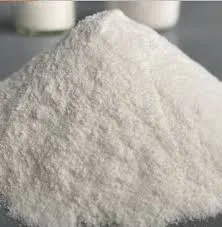
Aug . 30, 2024 05:18 Back to list
Hydroxyethyl Cellulose Synthesis - A Comprehensive Guide
Synthesis and Applications of Hydroxyethyl Cellulose
Hydroxyethyl cellulose (HEC) is a widely used non-ionic water-soluble polymer derived from cellulose, a naturally occurring polysaccharide obtained from the cell walls of plants. The synthesis of HEC involves the etherification of cellulose with ethylene oxide in the presence of an alkaline catalyst, which results in the substitution of hydroxyethyl groups for hydroxyl groups in the cellulose structure. This modification not only enhances the solubility of cellulose in water but also modifies its physical properties, making it a versatile additive in various industries.
The synthesis process typically begins with the purification of cellulose, which is often derived from wood pulp or cotton. The cellulose is then dissolved in an appropriate solvent, such as water or an organic solvent, and treated with ethylene oxide under controlled conditions. The addition of an alkaline catalyst, such as sodium hydroxide, facilitates the etherification reaction, allowing the ethylene oxide to react with the hydroxyl groups on the cellulose molecules. The degree of substitution, which indicates the average number of hydroxyethyl groups added per glucose unit in the cellulose, can be controlled by adjusting the reaction time and the concentration of the reagents.
Synthesis and Applications of Hydroxyethyl Cellulose
In the pharmaceutical industry, HEC is often utilized as a thickening agent and stabilizer in topical formulations, gels, and eye drops. Its ability to enhance the viscosity of solutions allows for improved product consistency and performance. Additionally, HEC is biocompatible and non-toxic, making it suitable for use in healthcare products.
hydroxyethyl cellulose synthesis

In cosmetics, HEC serves as a key ingredient in creams, lotions, and shampoos, where it contributes to the texture and overall feel of the product. Its film-forming properties help in creating a smooth application and improve moisture retention. Furthermore, HEC is used in hair care products to provide body and manageability.
In the food industry, HEC acts as a thickener, emulsifier, and stabilizer, enhancing the texture and consistency of various food products. It is often added to sauces, dressings, and dairy products to improve mouthfeel and extend shelf life.
Moreover, the construction industry benefits from HEC's properties as a water-retaining agent in cement and mortar formulations. The inclusion of HEC improves workability and helps to maintain moisture levels during the curing process, leading to stronger and more durable constructions.
In conclusion, the synthesis of hydroxyethyl cellulose through the etherification of cellulose is a crucial process that yields a versatile polymer with a wide range of applications. Its ability to enhance viscosity, stabilize formulations, and improve texture has made HEC a valuable ingredient across various industries, reinforcing its place as a fundamental additive in both consumer products and industrial applications.
-
Versatile Hpmc Uses in Different Industries
NewsJun.19,2025
-
Redispersible Powder's Role in Enhancing Durability of Construction Products
NewsJun.19,2025
-
Hydroxyethyl Cellulose Applications Driving Green Industrial Processes
NewsJun.19,2025
-
Exploring Different Redispersible Polymer Powder
NewsJun.19,2025
-
Choosing the Right Mortar Bonding Agent
NewsJun.19,2025
-
Applications and Significance of China Hpmc in Modern Industries
NewsJun.19,2025







